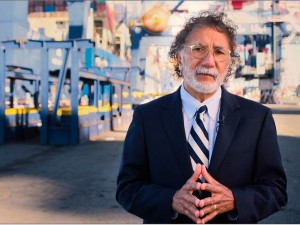In his ‘State of the Port’ address, Mario Cordero, executive director, Port of Long Beach paid tribute to the men and women keeping the Port operational during the pandemic and demonstrating that the Port is “not deterred by the pandemic.”
Cordero asked for a moment of silence to honor longshore workers who had lost their lives during the COVID-19 pandemic. He praised the work of longshore workers, truckers, port staff and maritime stakeholders.

In spite of the COVID virus Cordero noted that the Port had a record year.
The Port of Long Beach moved more than 8.1 million twenty-foot equivalent container units (TEUs) in 2020, setting a record.
The Port ended 2020, its busiest year on record, with 8,113,315 TEUs moved, an increase of 6.3% from 2019. Imports rose 6.4% to 3,998,340 TEUs. Exports totaled 1,475,888 TEUs, up 0.2%, while empty containers increased 9.9% to 2,639,088 TEUs. The Port exceeded the previous annual record set in 2018 by 22,292 TEUs.
Cordero thanked the Port workforce for this achievement: “I want to thank our frontline workers on the docks who kept cargo moving during this unprecedented moment in history, ensuring the safe, secure and timely delivery of vital medical equipment and consumer goods,”
He added: “We have all endured incredible hardships with COVID-19, but I am looking forward to 2021 as a time of economic recovery and a renewed focus on our industry partners, infrastructure projects and community stakeholders.”
Harbor Commissioner Bobby Olvera Jr., international vice president (Mainland) of the International Longshore and Warehouse Union (ILWU), also praised “our workforce for answering the call despite the many challenges along the way.”
In other news:
- The highly automated Long Beach Container Terminal (LBCT) is in its final stage of construction before becoming fully operational. LBCT operates electronically with zero emissions. At total capacity, the terminal can handle 3.1 million TEUs.
- The replacement of the Gerald Desmond Bridge was opened in October. The newly opened Port of Long Beach Bridge “will help boost trade” by reducing delays and bottlenecks and increasing the flow of truck traffic between the Ports of Long Beach and Los Angeles and to Southern California freeways. The new bridge, which cost nearly $1.5 billion, increases the number of lanes in each direction to 3 compared to the 2 lanes on the old Gerald Desmond Bridge. The new bridge adds an emergency lane in each direction.
- The Clean Air Action Plan goals to transition away from diesel powered equipment and trucks to zero and near zero emission cargo-handling equipment by 2030 and zero emission trucks by 2035 remain on track with Port tenants testing 60 pieces of equipment that is zero emission. Cordero reported that currently 15% of Port cargo-handling operations are zero emission and expressed the hope that zero emission goals would be met before their deadlines.
- “Amazon world is here to stay” and logistics operations need to adjust to higher volumes and faster delivery times of e-commerce that expanded during 2020 as consumers ordered more merchandise online in response to pandemic stay at home worders.

